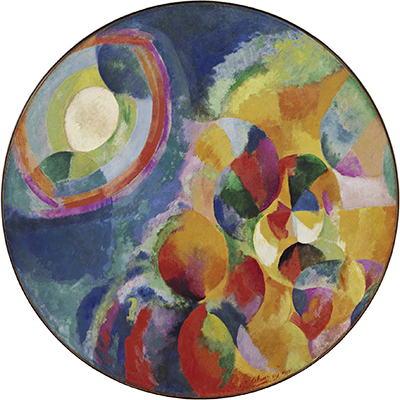Simultaneous Contrasts: Sun and Moon comes from a series of Robert Delaunay paintings in the early 20th century.
Introduction
The early 20th century was filled with artists experimenting with colour, and many would produce theories around that, including Paul Klee. Robert Delaunay was similarly interested in this aspect of visual art, specifically in combining colours together, and the impacts that this would have.
His investigation into this included a series in the early 1910s known as Simultaneous Contrasts, which included the Sun and Moon depiction found here, as well as Simultaneous Windows which captures a view from a window.
Description
We find the sun and moon represented by the two sides of this painting. The artist chooses to make use of a round canvas, which is an unusual choice but matches the content of the work. Delaunay wanted to create the feeling of the plants around us, and a traditional squared canvas might not have achieved this. The painting sees us viewing the sun and moon from a particular angle, perched just behind the moon.
The area to the left hand side features a much brighter tone, capturing our attention. It also contrasts strongly against the blue tones which represents the wider sky. Yellows, reds, oranges and purples then illuminate the rest of the scene in this bright and charming painting. The artist was also considering movement in this piece, where planets change positions in relation to each other, rotating as they go.
It is notable to compare the different items in his Simultaneous Contrasts series to understand the impact made by switching to a round canvas. It really exaggerates the rounded features, as well as promoting the overall theme of planets. It is also highly creative to switch the canvas in this manner, which was not a common sight in this period of art history.
Constellations as Inspiration for 20th Century Artists
Constellations and planets would interest artists across the 20th century, partly fuelled by man's visits to the moon. Miro was one such artist, and used similarly bright tones to produce abstract interpretations of the sky above him. Abstract artists would often rely on simple shapes, making constellations an ideal choice, particularly with their connection to child's stories and primitive art which also connects well with early 20th century contemporary art.
Painting Details
Simultaneous Contrasts: Sun and Moon was completed by Robert Delaunay in 1913 and today resides in the MoMA in the US. This circular canvas measures 53" (134.5 cm) in diameter and has a connection to the Guggenheim family, who also donated some of the artist's work to the Guggenheim Musem.
Conclusion
Simultaneous Contrasts: Sun and Moon provides a modern approach to a theme which has inspired artists for many centuries. The sky above us has always held a symbolic meaning, as well as connecting to religion and spirituality. Modern artists would start to focus on the shapes and colours, as well as the ways in which the various planets would interact with each other. Delaunay contributed his Simultaneous series in his mid to late twenties, and was displaying influences from the likes of Cezanne and Braque.




